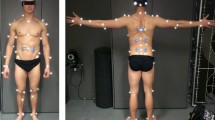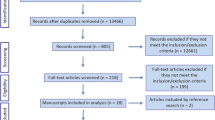Abstract
Musculoskeletal models have traditionally relied on measurements of segment kinematics and ground reaction forces and moments (GRF&Ms) from marked-based motion capture and floor-mounted force plates, which are typically limited to laboratory settings. Recent advances in inertial motion capture (IMC) as well as methods for predicting GRF&Ms have enabled the acquisition of these input data in the field. Therefore, this study evaluated the concurrent validity of a novel methodology for estimating the dynamic loading of the lumbar spine during manual materials handling based on a musculoskeletal model driven exclusively using IMC data and predicted GRF&Ms. Trunk kinematics, GRF&Ms, L4–L5 joint reaction forces (JRFs) and erector spinae muscle forces from 13 subjects performing various lifting and transferring tasks were compared to a model driven by simultaneously recorded skin-marker trajectories and force plate data. Moderate to excellent correlations and relatively low magnitude differences were found for the L4–L5 axial compression, erector spinae muscle and vertical ground reaction forces during symmetrical and asymmetrical lifting, but discrepancies were also identified between the models, particularly for the trunk kinematics and L4–L5 shear forces. Based on these results, the presented methodology can be applied for estimating the relative L4–L5 axial compression forces under dynamic conditions during manual materials handling in the field.






Similar content being viewed by others
Abbreviations
- GRF&Ms:
-
Ground reaction forces and moments
- IMC:
-
Inertial motion capture
- JRF:
-
Joint reaction force
- IDA:
-
Inverse dynamic analysis
- OMC:
-
Optical motion capture
- GRF:
-
Ground reaction force
- IMU:
-
Inertial measurement unit
- OMC-MGRF:
-
Optical motion capture with measured ground reaction forces
- OMC-PGRF:
-
Optical motion capture with predicted ground reaction forces
- IMC-PGRF:
-
Inertial motion capture with predicted ground reaction forces
- GRM:
-
Ground reaction moment
- %BW:
-
Percentage of body weight
- %BW*BH:
-
Percentage of body weight times body height
- RMSE:
-
Root-mean-square error
- rRMSE:
-
Relative root-mean-square error
- ICC:
-
Intraclass correlation coefficient
- LoA:
-
Limits of agreement
References
Andersen, M. S., M. Damsgaard, B. MacWilliams, and J. Rasmussen. A computationally efficient optimisation-based method for parameter identification of kinematically determinate and over-determinate biomechanical systems. Comput. Methods Biomech. Biomed. Eng. 13:171–183, 2010.
Andersen, M. S., M. Damsgaard, and J. Rasmussen. Kinematic analysis of over-determinate biomechanical systems. Comput. Methods Biomech. Biomed. Eng. 12:371–384, 2009.
Arshad, R., T. Zander, M. Dreischarf, and H. Schmidt. Influence of lumbar spine rhythms and intra-abdominal pressure on spinal loads and trunk muscle forces during upper body inclination. Med. Eng. Phys. 38:333–338, 2016.
Bassani, T., E. Stucovitz, Z. Qian, M. Briguglio, and F. Galbusera. Validation of the AnyBody full body musculoskeletal model in computing lumbar spine loads at L4L5 level. J. Biomech. 58:89–96, 2017.
Bland, M. J., and G. D. Altman. Measuring agreement in method comparison studies. Stat. Methods Med. Res. 8:135–160, 1999.
Carbone, V., R. Fluit, P. Pellikaan, M. M. van der Krogt, D. Janssen, M. Damsgaard, L. Vigneron, T. Feilkas, H. F. J. M. Koopman, and N. Verdonschot. TLEM 2.0—a comprehensive musculoskeletal geometry dataset for subject-specific modeling of lower extremity. J. Biomech. 48:734–741, 2015.
de Zee, M., L. Hansen, C. Wong, J. Rasmussen, and E. B. Simonsen. A generic detailed rigid-body lumbar spine model. J. Biomech. 40:1219–1227, 2007.
Deyo, R. A., and J. N. Weinstein. Low back pain. N. Engl. J. Med. 344:363–370, 2001.
Dreischarf, M., A. Shirazi-Adl, N. Arjmand, A. Rohlmann, and H. Schmidt. Estimation of loads on human lumbar spine: a review of in vivo and computational model studies. J. Biomech. 49:833–845, 2016.
Faber, G. S., C. C. Chang, I. Kingma, J. T. Dennerlein, and J. H. van Dieën. Estimating 3D L5/S1 moments and ground reaction forces during trunk bending using a full-body ambulatory inertial motion capture system. J. Biomech. 49:904–912, 2016.
Faber, G. S., I. Kingma, N. Delleman, and J. van Dieën. Effect of ship motion on spinal loading during manual lifting. Ergonomics 51:1426–1440, 2008.
Filippeschi, A., N. Schmitz, M. Miezal, G. Bleser, E. Ruffaldi, and D. Stricker. Survey of motion tracking methods based on inertial sensors: a focus on upper limb human motion. Sensors 17:1257, 2017.
Fluit, R., M. S. Andersen, S. Kolk, N. Verdonschot, and H. F. Koopman. Prediction of ground reaction forces and moments during various activities of daily living. J. Biomech. 47:2321–2329, 2014.
Frankenfield, D. C., W. A. Rowe, R. N. Cooney, J. S. Smith, and D. Becker. Limits of body mass index to detect obesity and predict body composition. Nutrition 17:26–30, 2001.
Galibarov, P. E., S. Dendorfer, and J. Rasmussen. Two computational models of the lumbar spine: comparison and validation. In: ORS Annual Meeting 2011, 2011.
Gallagher, S., and W. S. Marras. Tolerance of the lumbar spine to shear: a review and recommended exposure limits. Clin. Biomech. 27:973–978, 2012.
Han, K. S., T. Zander, W. R. Taylor, and A. Rohlmann. An enhanced and validated generic thoraco-lumbar spine model for prediction of muscle forces. Med. Eng. Phys. 34:709–716, 2012.
Hansen, L., M. De Zee, J. Rasmussen, T. B. Andersen, C. Wong, and E. B. Simonsen. Anatomy and biomechanics of the back muscles in the lumbar spine with reference to biomechanical modeling. Spine (Phila. Pa. 1976) 31:1888–1899, 2006.
Ignasiak, D., S. J. Ferguson, and N. Arjmand. A rigid thorax assumption affects model loading predictions at the upper but not lower lumbar levels. J. Biomech. 49:3074–3078, 2016.
Karatsidis, A., G. Bellusci, H. Schepers, M. de Zee, M. Andersen, and P. Veltink. Estimation of ground reaction forces and moments during gait using only inertial motion capture. Sensors 17:75, 2016.
Karatsidis, A., M. Jung, H. M. Schepers, G. Bellusci, M. de Zee, P. H. Veltink, and M. S. Andersen. Musculoskeletal model-based inverse dynamic analysis under ambulatory conditions using inertial motion capture. Med. Eng. Phys. 57:1–31, 2019.
Koning, B. H. W., M. M. van der Krogt, C. T. M. Baten, and B. F. J. M. Koopman. Driving a musculoskeletal model with inertial and magnetic measurement units. Comput. Methods Biomech. Biomed. Eng. 18:1003–1013, 2015.
Koo, T. K., and M. Y. Li. A guideline of selecting and reporting intraclass correlation coefficients for reliability research. J. Chiropr. Med. 15:155–163, 2016.
Leardini, A., A. Chiari, U. DellaCroce, and A. Cappozzo. Human movement analysis using stereophotogrammetry, Part 3 Soft tissue artifact assessment and compensation. Gait Posture 21:212–225, 2005.
McLaughlin, P. Testing agreement between a new method and the gold standard-How do we test? J. Biomech. 46:2757–2760, 2013.
Meldrum, D., C. Shouldice, R. Conroy, K. Jones, and M. Forward. Test–retest reliability of three dimensional gait analysis: including a novel approach to visualising agreement of gait cycle waveforms with Bland and Altman plots. Gait Posture 39:265–271, 2014.
Moisio, K. C., D. R. Sumner, S. Shott, and D. E. Hurwitz. Normalization of joint moments during gait: a comparison of two techniques. J. Biomech. 36:599–603, 2003.
NIOSH. Work Practices Guide for Manual Lifting. Washington, DC: NIOSH, 1981.
Rajaee, M. A., N. Arjmand, A. Shirazi-Adl, A. Plamondon, and H. Schmidt. Comparative evaluation of six quantitative lifting tools to estimate spine loads during static activities. Appl. Ergon. 48:22–32, 2015.
Rasmussen, J., M. de Zee, and S. Carbes. Validation of a biomechanical model to the lumbar spine. In Proceedings, XXIInd Congress of the International Society of Biomechanics, 5–9 July 2009, Cape Town, South Africa, 2009.
Rasmussen, J., M. De Zee, M. Damsgaard, S. Tørholm Christensen, C. Marek, and K. Siebertz. A general method for scaling musculo-skeletal models. In 2005 International Symposium on Computer Simulation in Biomechanics, Cleveland, OH, vol. 3, 2005.
Ren, L., R. K. Jones, and D. Howard. Whole body inverse dynamics over a complete gait cycle based only on measured kinematics. J. Biomech. 41:2750–2759, 2008.
Roetenberg, D., H. J. Luinge, and P. Slycke. Xsens MVN: Full 6DOF human motion tracking using miniature inertial sensors. Technical Report. Xsens Motion Technologies BV, Enschede, The Netherlands, 2013.
Shrout, P. E., and J. L. Fleiss. Intraclass correlations: uses in assessing rater reliability. Psychol. Bull. 86:420–428, 1979.
Skals, S., M. K. Jung, M. Damsgaard, and M. S. Andersen. Prediction of ground reaction forces and moments during sports-related movements. Multibody Syst. Dyn. 39:175–195, 2017.
Skals, S., K. P. Rasmussen, K. M. Bendtsen, J. Yang, and M. S. Andersen. A musculoskeletal model driven by dual Microsoft Kinect Sensor data. Multibody Syst. Dyn. 41:297–316, 2017.
Van der Helm, F. C. T., H. E. J. Veeger, G. M. Pronk, L. H. V. Van der Woude, and R. H. Rozendal. Geometry parameters for musculoskeletal modelling of the shoulder system. J. Biomech. 25:129–144, 1992.
Van Dieën, J. H. H., H. Weinans, and H. M. M. Toussaint. Fractures of the lumbar vertebral endplate in the etiology of low back pain: a hypothesis on the causative role of spinal compression in aspecific low back pain. Med. Hypotheses 53:246–252, 1999.
Veeger, H. E. J., F. C. T. Van Der Helm, L. H. V. Van Der Woude, G. M. Pronk, and R. H. Rozendal. Inertia and muscle-contraction parameters for musculoskeletal modeling of the shoulder mechanism. J. Biomech. 24:615, 1991.
Veeger, H. E. J., B. Yu, K. N. An, and R. H. Rozendal. Parameters for modeling the upper extremity. J. Biomech. 30:647–652, 1997.
Veltink, P. H., C. Liedtke, E. Droog, and H. Van Der Kooij. Ambulatory measurement of ground reaction forces. IEEE Trans. Neural Syst. Rehabil. Eng. 13:423–427, 2005.
Waters, T. R., V. Putz-Anderson, A. Garg, and L. J. Fine. Revised NIOSH equation for the design and evaluation of manual lifting tasks. Ergonomics 36:749–776, 1993.
Wilke, H.-J., P. Neef, B. Hinz, H. Seidel, and L. Claes. Intradiscal pressure together with anthropometric data—a data set for the validation of models. Clin. Biomech. 16(Suppl 1):S111–S126, 2001.
Winter, D. A. Biomechanics and Motor Control of Human Movement. Hoboken, NJ: Wiley, 2009.
Acknowledgments
This work was supported by the Independent Research Fund Denmark under Grant No. DFF-7026-00099 to Sebastian Skals.
Conflict of interest
Mark de Zee is co-founder of the company AnyBody Technology A/S that owns and sells the AnyBody Modeling System, which was used for the simulations. Mark de Zee is also a minority shareholder in the company.
Author information
Authors and Affiliations
Corresponding author
Additional information
Associate Editor Thurmon E. Lockhart oversaw the review of this article.
Publisher's Note
Springer Nature remains neutral with regard to jurisdictional claims in published maps and institutional affiliations.
Electronic supplementary material
Below is the link to the electronic supplementary material.
Rights and permissions
About this article
Cite this article
Larsen, F.G., Svenningsen, F.P., Andersen, M.S. et al. Estimation of Spinal Loading During Manual Materials Handling Using Inertial Motion Capture. Ann Biomed Eng 48, 805–821 (2020). https://doi.org/10.1007/s10439-019-02409-8
Received:
Accepted:
Published:
Issue Date:
DOI: https://doi.org/10.1007/s10439-019-02409-8




